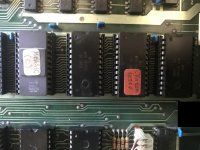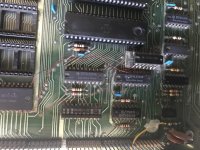Hi,
I got a PET 3032 and brought it to a state in which it seems like it works, but not completely.
The cursor is not a blinking square, but @ sign and it gives me syntax error on every return, no matter what is typed in.
Keyboard works fine, all keys are ok and I can move cursor, go home and clear screen correctly.
When I press return, @ cursor changes to A, then B, then C and then it goes to the bottom of the screen and fills the screen with some garbage.
The cursor can be still moved though and I can press clear screen and repeat everything.
Maybe it sounds some bell and you can point me to the right direction.
I have four ROM chips installed, they at least are powered correctly and are readable, though no idea if they don't have some malformed data.
RAM seems to be working fine - I tried switching the chips between the two banks (selected by CAS lines) and no change.
Here is a movie illustrating the problem:
Thank you very much
Pawel
I got a PET 3032 and brought it to a state in which it seems like it works, but not completely.
The cursor is not a blinking square, but @ sign and it gives me syntax error on every return, no matter what is typed in.
Keyboard works fine, all keys are ok and I can move cursor, go home and clear screen correctly.
When I press return, @ cursor changes to A, then B, then C and then it goes to the bottom of the screen and fills the screen with some garbage.
The cursor can be still moved though and I can press clear screen and repeat everything.
Maybe it sounds some bell and you can point me to the right direction.
I have four ROM chips installed, they at least are powered correctly and are readable, though no idea if they don't have some malformed data.
RAM seems to be working fine - I tried switching the chips between the two banks (selected by CAS lines) and no change.
Here is a movie illustrating the problem:
Thank you very much
Pawel


